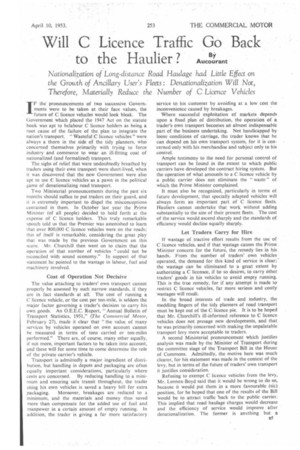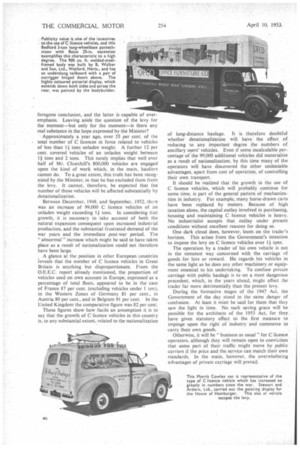Will C Licence Traffic Go Back to the Flaulier ? L';
Page 39

Page 40

If you've noticed an error in this article please click here to report it so we can fix it.
A u coil_ rant A u coil_ rant Nationalization of Long-distance Road Haulage had Little Effect on the Growth of Ancillary User's Fleets: Denationalization Will Not, Therefore, Materially Reduce the Number of C Licence Vehicles IF the pronouncements of two successive Governments were to be taken at their face values, the future of C licence vehicles would look bleak. The Government which placed the 1947 Act on the statute book was apt to belabour C licence holders as being a root cause of the failure of the plan to integrate the nation's transport. "Wasteful C licence vehicles " were always a thorn in the side of the tidy planners, who concerned themselves primarily with trying to force industry and commerce to wear an ill-fitting coat of nationalized (and formalized) transport.
The sighs of relief that were undoubtedly breathed by traders using their own transport were short-lived, when it was discovered that the new Government were also apt to use C licence vehicles as a pawn in the political game of denationalizing road transport,
Two Ministerial pronouncements during the past six months should suffice to put traders on their guard, and it is extremely important to dispel the misconceptions contained in them. In October last year the Prime Minister (of all people) decided to hold forth at the expense of C licence holders. This truly remarkable speech told us that the Premier was astonished to learn that over 800,000 C licence vehicles were on the roads; this of itself is remarkable, considering the great play that was made by the previous Government on this score, Mr. Churchill then went on to claim that the operation of that number of vehicles "could not be reconciled with sound economy.In support of that statement he pointed to the wastage in labour, fuel and machinery involved.
Cost of Operation Not Decisive The value attaching to traders' own transport cannot properly be assessed by such narrow standards, if they are in fact standards at all. The cost of running a C licence vehicle, or the cost per ton-mile, is seldom the major factor governing a trader's decision to carry his own goods. An 0.E.E.C. Report, "Annual Bulletin of Transport Statistics, 1951," (The Commercial Motor, February 27), made it clear that "the value of many services by vehicles operated on own account cannot be measured in terms of tons carried or ton-miles performed." There are, of course, many other equally, if not more, important factors to be taken into account, and these will for some time to come determine the role of the private carrier's vehicle.
Transport is admittedly a major ingredient of distribution, but handling in depots and packaging are often equally important considerations, particularly where costs are concerned. By reducing handling to a minimum and ensuring safe transit throughout, the trader using his own vehicles is saved a heavy bill for extra packaging. Moreover, breakages are reduced to a minimum, and the materials and money thus saved more than compensate for the added use of fuel and manpower in a certain amount of empty running. In addition, the trader is giving a far more satisfactory service to his customer by avoiding at a low cost the inconvenience caused by breakages.
Where successful exploitation of markets depends upon a fixed plan of distribution, the operation of a trader's own transport becomes an almost indispensable part of the business undertaking. Not handicapped by loose conditions of carriage, the trader knows that he can depend on his own transport system, for it is concerned only with his merchandise and subject only to his control.
Ample testimony to the need for personal control of transport can be found in the extent to which public carriers have developed the contract hiring system. But the operation of what amounts to a C licence vehicle by a public carrier does not eliminate the "waste" of which the Prime Minister complained.
It must also be recognized, particularly in terms of future development, that specially adapted vehicles will always form an important part of C licence fleets. Hauliers cannot undertake that work without adding substantially to the size of their present fleets. The cost of the service would ascend sharply and the standards of efficiency would decline equally sharply.
Let Traders Carry for Hire If wastage of .tractive effort, results from the use of C licence vehicles, and if that wastage causes the Prime• Minister concern for the future, the remedy lies in his hands.. From the number of traders' own vehicles operated, the demand for this kind of service is clear: the wastage can be eliminated to a great extent by authorizing a C licensee, if he so desires, to carry Other traders' goods in his vehicles to avoid empty running. This is the true remedy, for if any attempt is made to restrict C licence vehicles, far more serious and costly wastages will result.
In the broad interests of trade and industry, the meddling fingers of the tidy planners of road transport must be kept out of the C licence pie. It is to be hoped that Mr. Churchill's ill-informed reference to C licence vehicles does not presage new developments, and that he was primarily concerned with making the unpalatable transport levy more acceptable to traders.
A second Ministerial pronouncement which justifies analysis was made by the Minister of Transport during the committee stage of the Transport Bill in the House of Commons. Admittedly, the motive here was much clearer, for his statement was made in the context of the levy, but in terms of the future of traders' own transport it justifies consideration.
Refusing to exempt C licence vehicles from the levy, Mr. Lennox-Boyd said that &would be wrong to do so, because it would put them in a more favourable (sic) position, for he hoped that one of the results of the Bill would be to attract traffic back to the public carrier. This implied that road haulage charges would decrease and the efficiency of service would improve after denationalization. The former is anything but a
foregone Conclusion, and the latter is capable of overemphasis. Leaving aside the question of the levy for the moment—but only for the moment—is there any real substance in the hope expressed by the Minister?
Approximately a year ago, over 55 per cent, of the total number of C licences in force related to vehicles of less than 14 tons unladen weight. A further 12 per cent, covered vehicles of an unladen weight between 14 tons and 2 tons. This surely implies that well over half of Mr. Churchill's. 800,000 vehicles are engaged upon the kind of work which, in the main, hauliers cannot do. To a great extent, this truth has been recognized by the Minister, in that he has excluded them from the levy. It cannot, therefore, be expected that the number of those vehicles will be affected substantially by denationalization.
Between December, 1948, and September, 1952, there was an increase of 99,000 C licence vehicles of an unladen weight exceeding 14 tons. In considering that growth, it is necessary to take account of both the natural expansion consequent upon increased industrial production, and the substantial frustrated demand of the war years and the immediate post-war period. The " abnormal " increase which might be said to have taken place as a result of nationalization could not therefore have been large.
A glance at the position in other European countries reveals that the number of C licence vehicles in Great Britain is anything but disproportionate. From the 0.E.E.C. report already mentioned, the proportion of vehicles used on own account in Europe, expressed as a percentage of total fleets, appeared to be in the case of France 87 per cent. (excluding vehicles under 1 ton), in the Western Zones of Germany 81 per cent., in Austria 80 per cent., and in Belgium 91 per cent. In the United Kingdom the comparative figure was 82 per cent.
Those figures show how facile an assumption it is to say that the growth of C licence vehicles in this country is, to any substantial extent, related to the nationalization
of long-distance haulage. It is therefore doubtful whether denationalization will have the effect. of reducing to any important degree the numbers of ancillary users' vehicles. Even if some incalculable percentage of the 99,000 additional vehicles did materialize as a result of nationalization, by this time many of the operators will have discovered the other undeniable advantages, apart from cost of operation, of controlling their own transport.
It should be realized that the growth in the use of C licence vehicles, which will probably, continue for some time, is part of the general pattern of mechanization in industry. For example, many horse-drawn carts have been replaced by motors. Because of high taxation alone, the capital outlay involved in purchasing, housing and maintaining C licence vehicles is heavy. No industrialist accepts that outlay under present conditions without excellent reasons for doing so.
One dark cloud does, however, loom on the trader's horizon. This arises from the Government's intention to impose the levy on C licence vehicles over 14 tons.
The operation by a trader of his own vehicle is not in the remotest way concerned with the carriage of goods for hire or reward. He regards his vehicles in the same light as he does any other machinery or equipment essential to his undertaking. To confuse private carriage with public haulage is to set a most dangerous precedent, which, in the years ahead, might affect the trader far more detrimentally than the present levy.
During the formative stages of the 1947 Act, the Government of the day stood in the same danger of confusion. At least it must be said for them that they saw the light in time. No such saving grace will be possible for the architects of the 1953 Act, for they have given statutory effect to the first measure to impinge upon the right of industry and commerce to carry their own goods.
Otherwise, it will be" business as usual "for C licence operators, although they will remain open to conviction that some part of their traffic might move by public carriers if the price and the service can match their own standards. In the main, however, the overwhelming advantages of private carriage will prevail.




















































































